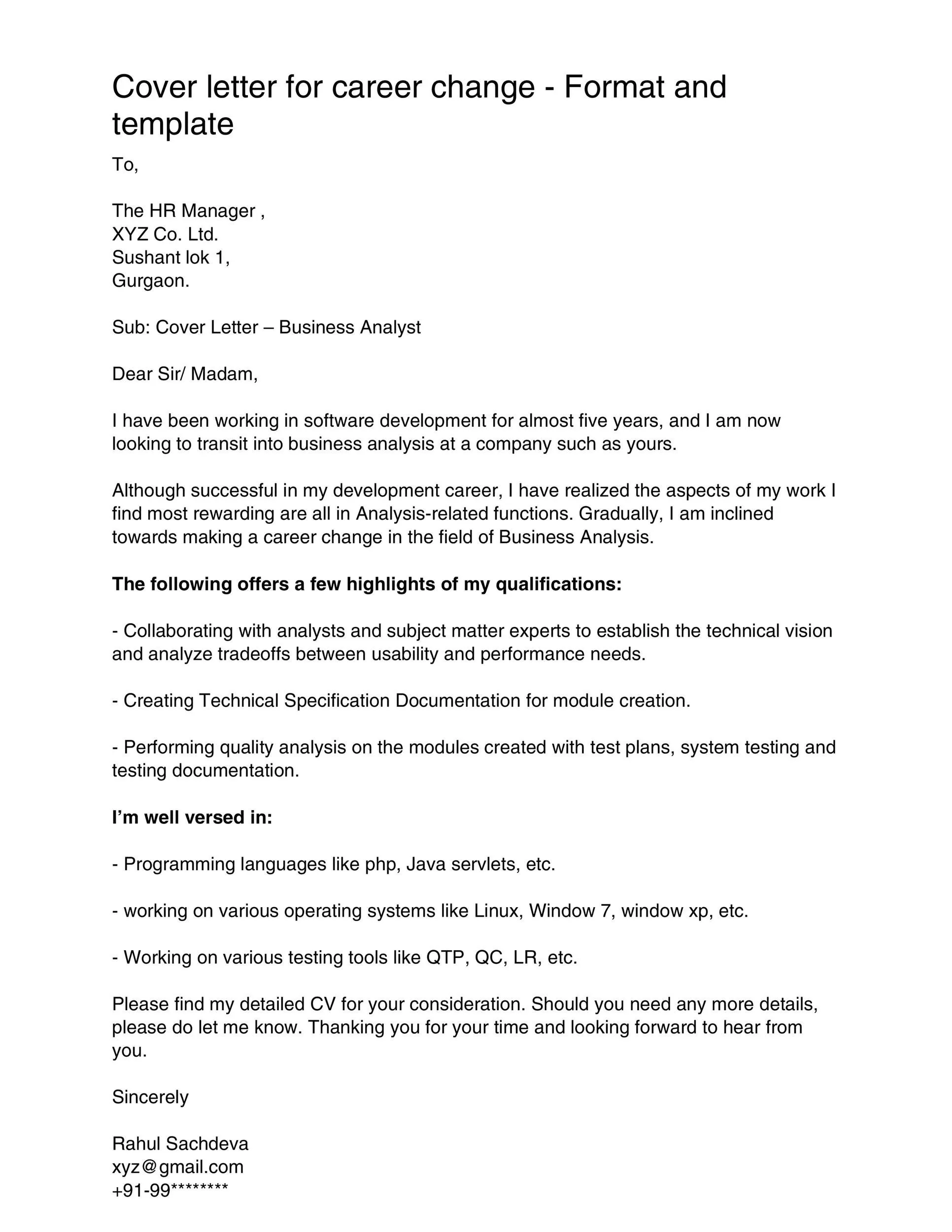Understanding the Career Change Cover Letter
A career change cover letter is a crucial tool for individuals seeking to transition into a new profession. Unlike a standard cover letter that primarily focuses on experience within a specific field, a career change cover letter aims to bridge the gap between your past experiences and the desired new role. It’s a strategic document designed to convince a potential employer that your skills, even if gained in a different industry, are transferable and valuable. This requires a different approach, emphasizing adaptability, willingness to learn, and the potential for growth within the new field. Your cover letter should be a well-crafted narrative that not only highlights your past achievements but also demonstrates how they align with the requirements of the new position.
Why is a Career Change Cover Letter Important
The importance of a career change cover letter lies in its ability to address the hiring manager’s potential concerns. When reviewing applications from candidates with non-traditional backgrounds, employers often wonder about the applicant’s ability to perform the job duties effectively. A well-written cover letter directly tackles these concerns by showcasing your transferable skills, explaining your motivations for the career change, and demonstrating your understanding of the new industry. Without a strong cover letter, your application might be overlooked, as the hiring manager may struggle to see the connection between your past experiences and the open position. Therefore, the cover letter is your opportunity to make a compelling case for your candidacy and increase your chances of landing an interview.
Highlighting Transferable Skills
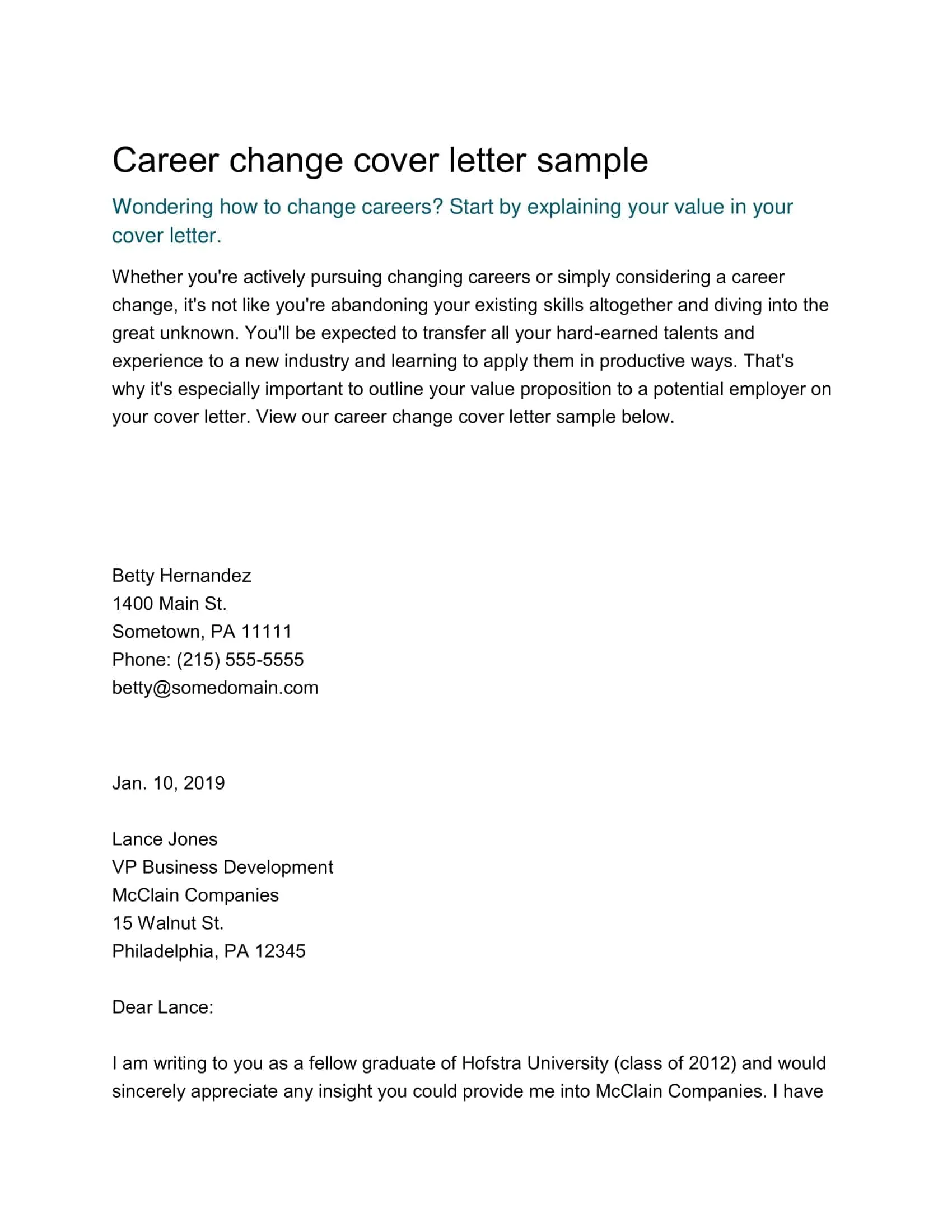
One of the most critical aspects of a career change cover letter is the ability to identify and highlight your transferable skills. These are the skills you’ve acquired in previous roles that are applicable to the new position. Common examples include communication, problem-solving, leadership, project management, and analytical skills. To effectively highlight these skills, you should analyze the job description for the new role and identify the key requirements. Then, reflect on your past experiences and pinpoint specific instances where you’ve demonstrated those skills. Be prepared to give examples. This might involve describing a time you successfully managed a project, resolved a complex issue, or led a team to achieve a goal. By demonstrating how your skills align with the new role’s demands, you increase your perceived value as a candidate. It is crucial to create a table with your transferable skills to show how those skills are relevant to the new job.
Focusing on Accomplishments
Rather than simply listing your responsibilities, your cover letter should emphasize your accomplishments. Quantifiable achievements are particularly effective, as they provide concrete evidence of your abilities. For instance, instead of stating that you “managed social media accounts,” you could say, “Increased social media engagement by 30% within six months.” This approach demonstrates that you’re not just capable but also results-oriented. Use the STAR method (Situation, Task, Action, Result) to structure your accomplishment-focused statements. Describe the situation, the task you were assigned, the actions you took, and the positive results you achieved. This technique adds depth and credibility to your claims, making them more persuasive to the hiring manager. Focusing on accomplishments instead of responsibilities helps you stand out from other applicants.
Tailoring Your Cover Letter
A generic cover letter is unlikely to impress an employer. It is crucial to tailor your cover letter to each specific job application. This involves researching the company and the role, understanding their needs, and demonstrating how your skills and experiences align with those needs. Start by carefully reviewing the job description. Identify the key requirements, skills, and qualifications. Then, customize your cover letter to address those specific points. This may involve adjusting the language you use, highlighting relevant experiences, and providing examples that directly address the employer’s needs. The more effort you put into tailoring your cover letter, the more likely you are to make a strong impression on the hiring manager. Personalization shows that you are serious about the position and have taken the time to understand the role.
Structure of a Compelling Cover Letter

A well-structured cover letter is easy to read and effectively conveys your key messages. A standard cover letter typically consists of an opening paragraph, body paragraphs, and a closing paragraph. Each section should serve a specific purpose in presenting your qualifications and enthusiasm. The opening paragraph should grab the reader’s attention and state your purpose for writing. The body paragraphs should delve into your relevant experiences, highlight your transferable skills, and showcase your accomplishments. The closing paragraph should reiterate your interest in the position and express your eagerness for an interview. A clear and organized structure helps guide the reader through your application, making it easier for them to understand your qualifications and appreciate your value. Structure your document in a clear, logical manner, using formatting to enhance readability.
Contact Information
At the top of your cover letter, include your contact information. This should include your full name, phone number, email address, and optionally, your LinkedIn profile URL. Make sure your contact information is accurate and up-to-date, as this is how the employer will reach you. Using a professional email address is essential. Avoid using informal or unprofessional email addresses. Ensure that your LinkedIn profile is also up-to-date and reflects the information presented in your cover letter and resume. The contact information is usually placed at the top left or right corner of the document. The format should be clean and easy to read.
Greeting the Hiring Manager
Start your cover letter with a professional greeting. If possible, address the hiring manager by name. This demonstrates that you’ve taken the time to research the company and the role. You can often find the hiring manager’s name on the company’s website, LinkedIn, or by contacting the company directly. If you can’t find the name, a general greeting like “Dear Hiring Manager” or “Dear [Department Name] Team” is acceptable. Avoid overly casual greetings, such as “Hey” or “Hi.” A professional greeting sets a positive tone and shows respect for the recipient. Make sure you spell the name correctly.
The Opening Paragraph
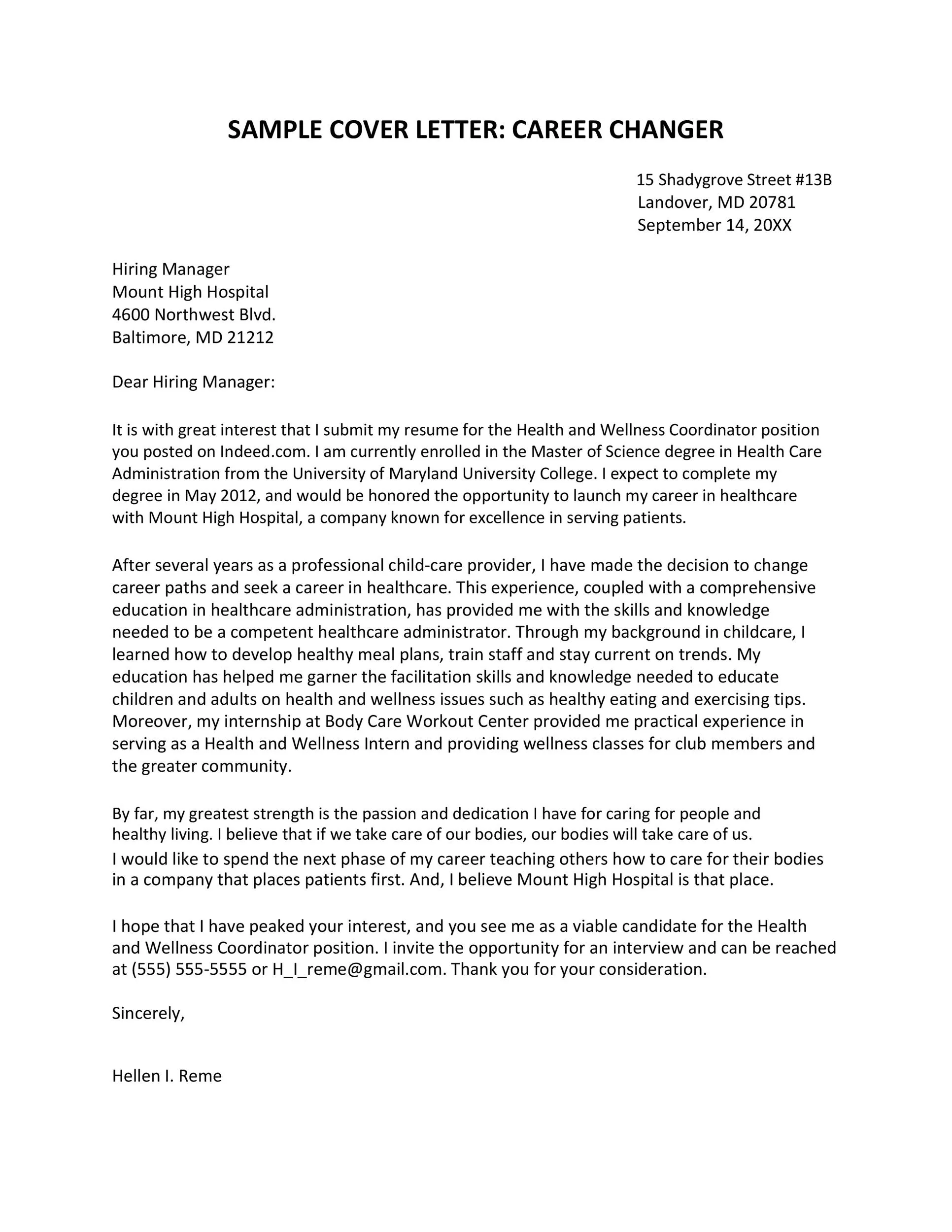
The opening paragraph is your opportunity to make a strong first impression. Start by stating the position you are applying for and where you found the job posting. Then, immediately capture the reader’s attention by briefly summarizing your key qualifications and your reason for pursuing the career change. Clearly state your interest in the role and your enthusiasm for the company. Mentioning your transferable skills or a notable accomplishment can be a great way to grab the reader’s attention. Keep the opening paragraph concise and impactful. The goal is to provide a quick overview of your suitability for the role and encourage the reader to continue reading.
Body Paragraphs
The body paragraphs are where you provide the details that support your claims. This section should highlight your relevant experiences, transferable skills, and accomplishments. Structure the body paragraphs logically, using one paragraph for each key point. Start with a topic sentence that introduces the main idea of each paragraph. Then, provide specific examples and evidence to support your claims. Use the STAR method (Situation, Task, Action, Result) to showcase your achievements. Each paragraph should be focused and easy to read. Avoid jargon or technical terms that the hiring manager may not understand. The goal is to make a compelling case for your candidacy and to demonstrate that you have the skills and experience necessary to excel in the new role.
Closing Paragraph
In the closing paragraph, reiterate your interest in the position and express your enthusiasm for the opportunity. Reiterate your key skills and qualifications briefly. Thank the hiring manager for their time and consideration. State that you look forward to the opportunity to discuss your application further. End with a professional closing, such as “Sincerely” or “Best regards,” followed by your name. Proofread the entire cover letter before submitting it to ensure there are no errors in grammar, spelling, or punctuation. This is your final chance to leave a positive impression on the hiring manager.
5 Career Change Cover Letter Examples
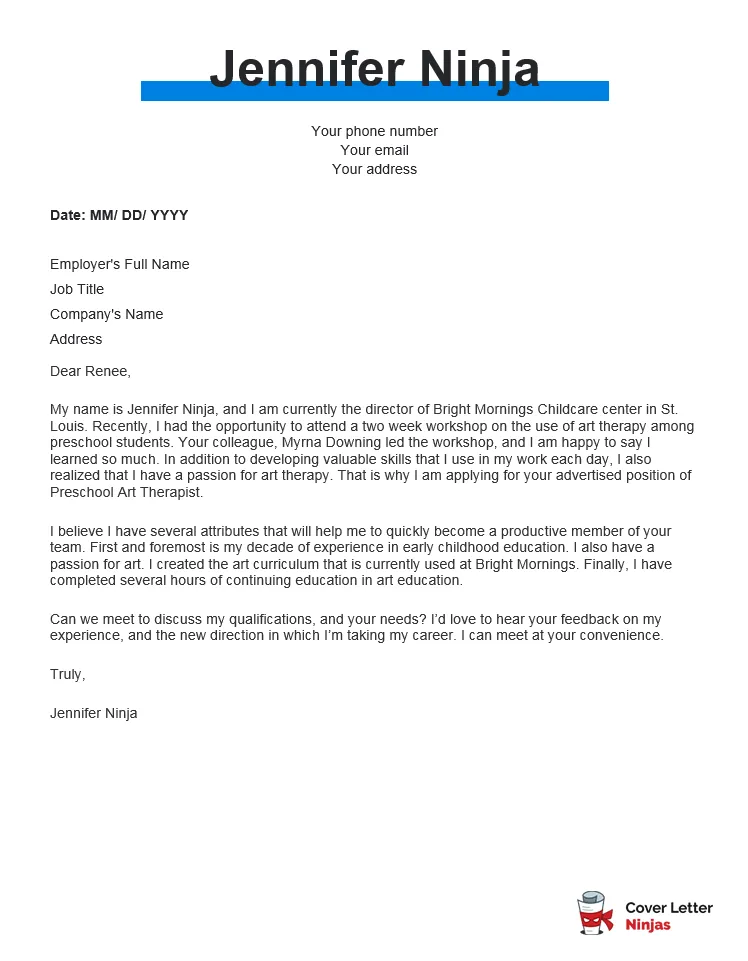
Below are examples of career change cover letters for different scenarios. These examples provide a practical guide to writing a compelling cover letter tailored to your unique career transition. They are intended to serve as inspiration and a template to help you showcase your skills effectively. Customize these examples to fit your specific situation. Focus on tailoring each example to your needs. Remember to replace the placeholder information with your own details.
Example 1 Accounting to Marketing
Imagine a professional transitioning from accounting to marketing. This candidate needs to highlight their analytical skills, attention to detail (from accounting), and how they can be applied to marketing. The cover letter emphasizes market research, data analysis, and budgeting expertise, aligning them with marketing strategies and campaign performance tracking. This shows how skills from one field are directly valuable in the other. This type of candidate demonstrates how the ability to analyze financial data can translate into analyzing marketing campaign performance.
Example 2 Teacher to Project Management
In this scenario, a teacher is moving into project management. The cover letter should focus on skills like organization, communication, leadership, and time management. The examples provided describe managing multiple projects (e.g., classroom activities, school events) and ensuring their successful completion. This demonstrates how the ability to manage classroom activities can be translated into managing projects in a corporate environment. The key is to emphasize how the ability to manage diverse student needs aligns well with managing varied project tasks.
Example 3 Healthcare to Tech
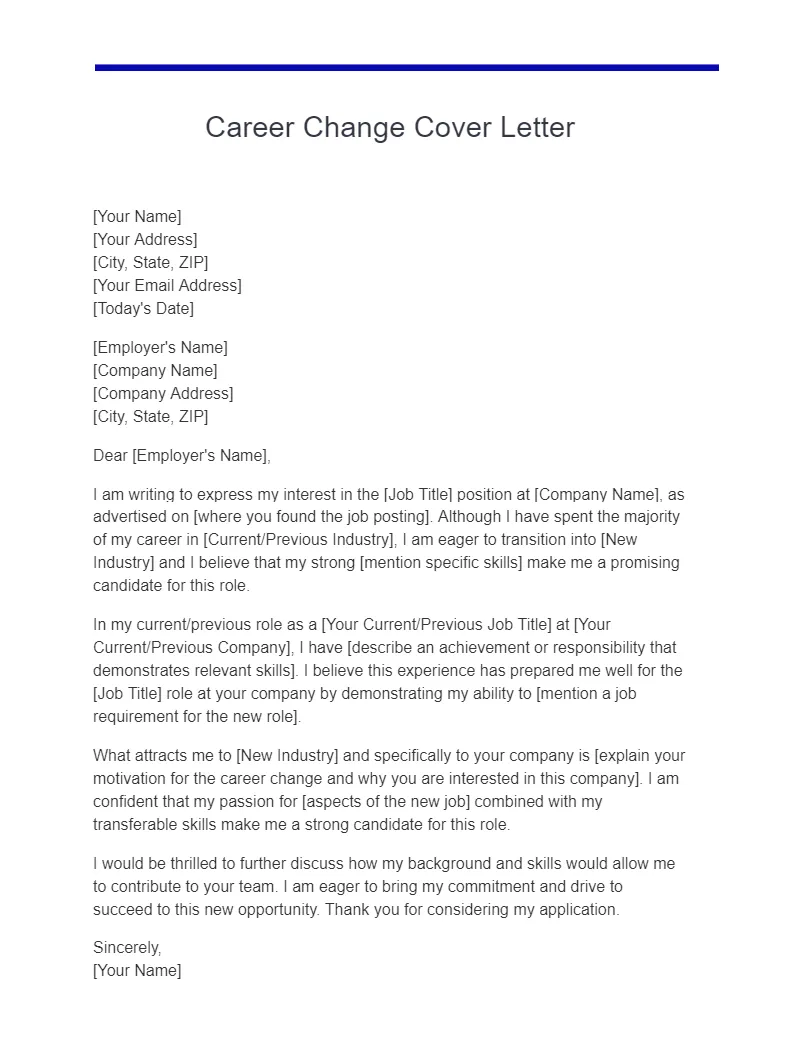
A healthcare professional transitioning into tech needs to emphasize adaptability, analytical skills, and problem-solving abilities. They must demonstrate an understanding of healthcare processes and patient needs. Examples may include process improvement projects that improved efficiency or enhanced patient care. This illustrates how healthcare professionals’ problem-solving skills translate to tech roles. The cover letter showcases the capacity to learn new technologies and leverage experience in a different setting. The healthcare professional’s capacity to quickly adapt and learn new processes are the most important aspects.
Example 4 Retail to Customer Service
For an individual moving from retail to customer service, the cover letter needs to emphasize communication, problem-solving, and customer relations skills. Specific examples might detail resolving customer issues, handling complaints, and exceeding sales targets. This showcases the transferable skills such as building rapport and providing excellent service. They are the most important aspect in the customer service industry. Showcasing the ability to handle difficult situations and maintaining a positive attitude will highlight the core competencies. The key is to connect retail experience with the requirements of the customer service role.
Example 5 Finance to Non-profit
A finance professional transitioning to a non-profit needs to highlight their financial management, budgeting, and organizational skills. The cover letter should emphasize experience in managing budgets, fundraising, and donor relations. Financial skills are highly valued in non-profits. This demonstrates the capacity to work with financial data, create budgets, and build relationships. The ability to manage financial resources, support fundraising initiatives, and meet organizational goals are very important. The key here is showing alignment with the non-profit’s mission and how your finance experience can contribute to their success.
Key Takeaways for Your Cover Letter
When writing a career change cover letter, keep the following key takeaways in mind: research the company and role, highlight transferable skills, focus on accomplishments, tailor your letter to the specific job, and maintain a professional tone. Proofread carefully. By following these guidelines, you can create a compelling cover letter that increases your chances of landing an interview and successfully transitioning to a new career. Remember, the goal is to present yourself as a strong, capable candidate with a genuine interest in the new role. With a well-crafted cover letter, you can effectively communicate your value to potential employers and open doors to new and exciting opportunities. A good cover letter will also show that you are willing to adapt to a new environment, which is essential for career changes.
